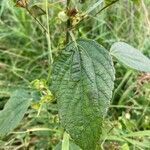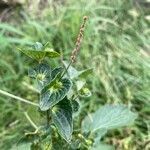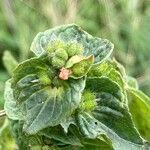Annual herbs, 0.2-0.5 m tall, monoecious. Branchlets pilose. Stipules lanceolate, 1.5-2 mm; petiole 2-6 cm; leaf blade oblong-ovate, ± rhombic-ovate, or broadly lanceolate, 3-9 × 1-5 cm, membranous, abaxially pilosulose along veins, adaxially glabrous, base cuneate, rarely obtuse, crenate, apex shortly acuminate. Inflorescences axillary, rarely terminal, unbranched, 1.5-5 cm, pilosulose, bisexual; peduncle 0.5-3 cm; female bracts proximal, 1 or 2(-4), ovate, cordate, accrescent to 1.4-2.5 × 1-2 cm in fruit, pilose, margin crenate; male portion distal, short to almost capitate, slender; bracts ovate, ca. 0.5 mm. Male flowers 5-7 per bract; pedicel ca. 0.5 mm; calyx segments 4, ca. 0.5 mm; stamens (7 or)8. Female flowers 1-3 per bract, sessile; sepals 3, narrowly ovate, 0.5-1 mm, pilose; ovary pilose; styles 3, ca. 2 mm, 5-7-laciniate. Capsule 3-locular, ca. 4 mm in diam., pilose and tuberculate. Seeds subovoid, 1.5-2 mm, smooth. Fl. and fr. Apr-Dec.
Herb, wiry, to 150 mm high. Leaves eglandular; lamina ovate to obovate, 9–85 mm long, 5–40 mm wide; base cuneate; margin shallowly crenate; tip acute; venation palminerved with 3 veins from base and 2–4 lateral veins per side of midrib. Inflorescences axillary and solitary, racemose-spicate; with 1 or 2 (–4) female bracts, 7–15 mm wide. Male flowers with sepals lanceolate, 0.4–0.5 mm long; stamens 8. Female flowers ± sessile; sepals lanceolate, c. 0.8 mm long; styles 1–2.5 mm long, clear to brownish. Fruit depressed-globose, c. 1.8 mm long, 2 mm diam. Seeds ovoid, 1.7–1.8 mm long, 1.1–1.3 mm wide.
A herb. It grows 10-50 cm tall. The leaves are sword shaped and 3-9 cm long by 1-5 cm wide. The flowers are in groups in the axils of leaves. There are 1-3 female flowers and 5-7 male flowers in



